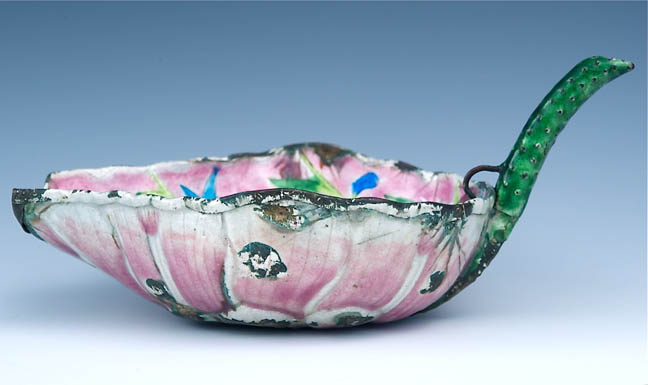

Title: Antique Silvered Copper Painted Enamel Water Dropper Chinese
Shipping: $18.00
Artist: N/A
Period: 19th Century
History: N/A
Origin: Central Asia > China
Condition: Good
Item Date: 1800 to 1920
Item ID: 3751
This is a very a rare hand made antique silvered copper painted enamel water dropper, it is Chinese. In the form of a lotus blossom with a handle. Enameled with a floral pattern on the interior, and lotus blossom on the exterior. Measures approx. 6"L x 4-1/3"W. Condition: Chips and losses to enamel on the rim, bottom and exterior. This is a beautiful copper enamel seemingly hand-painted water dropper, used in the calligraphy process. Water is placed into the bowl and pours out for use through the stem. This is a very special 20th century piece. Today, the market of Chinese art is widely reported to be among the hottest and fastest-growing in the world, attracting buyers all over the world. The Voice of America reported in 2006 that Chinese art is raking in record prices both internationally and in domestic markets. Sotheby's noted that Chinese art has rapidly changed the Asian art world into one of the most dynamic sectors on the international art market.
Link: http://en.wikipedia.org/wiki/Chinese_art
Chinese art (Chinese: 中國藝術/中国艺术) has varied throughout its ancient history, divided into periods by the ruling dynasties of China and changing technology. Different forms of art have been influenced by great philosophers, teachers, religious figures and even political leaders. Chinese art encompasses fine arts, folk arts and performance arts.
Early forms of art in China were made from pottery and jade in the Neolithic period, to which was added bronze in the Shang Dynasty. The Shang are most remembered for their blue casting, noted for its clarity of detail. Early Chinese music and poetry was influenced by the Book of Songs, Confucius and the Chinese poet and statesman Qu Yuan.
In early imperial China, porcelain was introduced and was refined to the point that in English the word china has become synonymous with high-quality porcelain. Around the 1st century AD, Buddhism arrived in China, though it did not become popular until the 4th century. At this point, Chinese Buddhist art began to flourish, a process which continued through the 20th century. It was during the period of Imperial China that calligraphy and painting became highly appreciated arts in court circles, with a great deal of work done on silk until well after the invention of paper.